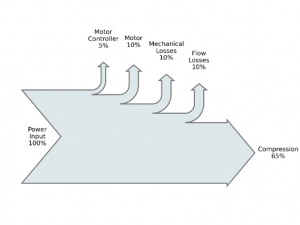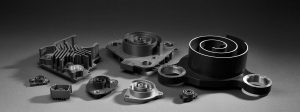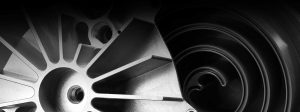Air Squared Articles
Scroll Compressor and Vacuum Pump Efficiency
An introduction to scroll technology efficiencies and associated losses.
When a scroll compressor or vacuum pump is selected for an application, the ultimate goal is to compress a low-pressure gas at the inlet of the machine and turn it into a compressed gas at the outlet. Even if the compression process is ideal, thermodynamics dictates that mechanical power is required to carry out this compression process. Like other types of compressors, scroll machines (compressors and vacuum pumps) do not carry out ideal compression processes, and the required power input is always higher due to inefficiencies. In addition, losses like leakage and heat transfer tend to decrease the amount of fluid that can be pumped by the machine, thereby decreasing the volumetric efficiency.

To understand the amount of electrical power required for the machine, we must understand the factors that contribute to a non-ideal compression process. In general, the losses in scroll machines fall into one of the following categories: mechanical losses, leakage losses, heat transfer, pressure drop, and over- or under-compression losses.
The different loss mechanisms are linked. For instance, mechanical losses contribute to a decrease in volumetric efficiency by heating the gas in the suction chamber. A reduction in the discharge pressure drop can increase the leakage losses. Optimization of scroll machine performance must take all of these interactions into account.
Mechanical Losses
Mechanical losses are caused by friction between two surfaces that are passing by each other at some speed. The amount of mechanical loss is proportional to the product of the applied load on the contact point and the velocity of the contact. Two surfaces that have a low applied load but a high contact speed will still experience significant mechanical losses.
There are a number of sources of mechanical losses in scroll machines, and these losses vary according to whether the unit is oil-free or oil-lubricated. For an oil-lubricated design, by far the dominant source is the radial bearings that are required to support the mechanical loads generated by the compression process. In a scroll machine, the bearings are also used to overcome the orbiting scroll’s desire to rotate and force it instead to take on an orbiting trajectory. Other sources of mechanical losses in an oil-lubricated compressor include frictional losses caused by rubbing of the orbiting and fixed scrolls, the thrust bearings required to carry the axial load, and any mechanical losses incurred by auxiliary systems, such as cooling fans, cooling water pumps, and so on.
For an oil-free design, the dominant source of mechanical losses is the rubbing between the tip-seal and the base of the scroll components. Since the scrolls do not contact and all loads are taken through ball bearings, the second largest source for mechanical losses are the bearings, which take both the radial and axial loads.
Leakage Losses
In an idealized scroll machine, the orbiting and fixed scrolls are manufactured perfectly and are in perfect contact throughout the compression process, which results in no area for leakage of gas from higher to lower pressure during the compression process. In a real scroll machine, manufacturing concerns dictate that the scroll wraps cannot be in perfect contact at all times. As a result, internal leakage is an unfortunate side effect.
In general, as the pressure ratio of the machine increases, the impact of leakage losses also increase. Leakage losses contribute to a reduction in both isentropic efficiency and volumetric efficiency. Heat transfer also has a complex relationship with leakage losses. The scroll wraps are locally heated and cooled, which means they expand or contract locally, which results in larger leakage gaps in some cases and smaller leakage gaps in others.
The decision to use an oil-free or oil-lubricated scroll machine has a significant impact on the leakage losses. With an oil-free machine, a specified clearance is set between the scrolls, with the intent of preventing any contact during operation. The presence of some oil in the scroll machine means that an oil film will partially fill the leakage gaps, resulting in significantly improved volumetric efficiency. The use of an oil-free design has other benefits, such as reduced mechanical losses, increased life, and a cleaner compression process (no presence of oil). However, the lack of oil results in a poorer volumetric performance.
Leakage losses have a significant negative impact on the volumetric efficiency of scroll machines. In a simplified fashion, leakage flows of higher-pressure gas into the suction volume can be thought of as taking up space in the suction volume, thereby leaving less space for the suction gas, resulting in a lower volumetric efficiency.
Heat Transfer
As other losses are experienced in the machine (particularly mechanical losses), heat transfer moves heat around the machine, cooling warm elements of the machine and warming up cooler elements. In general, the suction gas is one of the coolest elements in the machine. As a result, a significant portion of the mechanical losses can end up in the suction gas depending on where the suction is placed. As a gas is heated at constant pressure, its density decreases, which results in less gas being pumped by the machine. This results, in turn, in a decrease in compressor volumetric efficiency.
However if sufficient cooling is employed, the compression process can be shifted towards an isothermal (constant temperature) process, which reduces the amount of power required to compress the gas and improves efficiency.
Pressure Drop
Without pressure drop, no flow of fluid into the machine or out of the machine is possible. Both suction and discharge pressure drop result in an increase in compression power. Through proper sizing of the inlet and outlet ports and lines, pressure drop losses can be controlled.
Pressure drop has a significantly negative effect on both isentropic efficiency and volumetric efficiency. The integrator of scroll machines should also consider the pressure drops in the piping that is used to connect the scroll machine to its system. These external pressure drops can also have a negative impact on the measured performance of the scroll machine if they are selected improperly.
Motor and Controller
A motor converts electrical power into rotational mechanical power. This mechanical power is used to drive the orbiting motion of the orbiting scroll, which, in turn, carries out the compression process. This conversion from electrical power to mechanical power is not 100% efficient. Depending on the mechanical load on the motor, an efficiency of approximately 90% can be expected. The remaining electrical energy is dispersed as heat, which, depending on the construction of the scroll machine, might be transferred into the gas that is being compressed.
Furthermore, if the ability to change the rotational speed of the electrical motor is desired, it is necessary to have a motor controller that can change the speed of the motor. These motor speed controllers tend to have an efficiency on the order of 95%.
Conclusions
As a rough estimate, we can say that the mechanical efficiency is typically on the order of 90%, the leakage loss (and pressure drop) efficiency is on the order of 90%, and the motor efficiency is on the order of 90%. As a result, it is challenging to construct a scroll machine that has an overall isentropic efficiency of greater than approximately 65%. Figure 1 presents a graphical representation of the energy flows in the scroll machine based on these rough efficiency values.
The details of the construction of the machine have a strong impact on the overall balance of losses in the machine, and these efficiencies should be taken only as a rough guidance about where the input electrical power is going.





